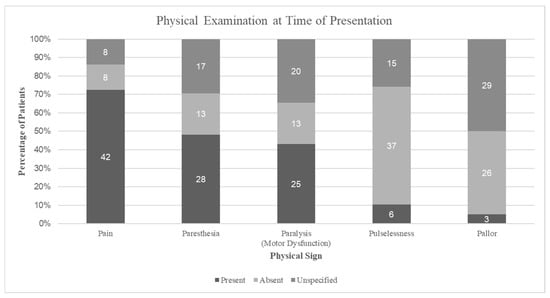- Article
Clinical Characteristics of Patients Undergoing Upper Extremity Fasciotomies for Compartment Syndrome at a Level I Trauma Center
- Stephanie H. Vu,
- Brandon J. De Ruiter and
- Samantha J. King
- + 3 authors
Background/Objectives: Early diagnosis and surgical intervention are critical in upper extremity (UE) compartment syndrome to prevent irreversible muscle necrosis or amputation. Despite its prevalence, there remains limited literature guiding surgical management or predictors of complications. This study aims to characterize risk factors and outcomes following UE fasciotomies. Methods: A 14-year (2010–2024) retrospective review was conducted of adult patients undergoing fasciotomies for UE compartment syndrome at a level 1 trauma center. Exclusion criteria included age <18 years, incomplete records, or fasciotomies not performed for compartment syndrome. Data collected include demographics, injury mechanism, presenting symptoms, and diagnostic methods. Intraoperative details obtained include incision type, number of interventions, closure method, presence of muscle necrosis, and amputation. Results: Fifty-five patients (58 extremities) met the inclusion criteria (median age 42 years; 85% male). Mechanisms included fractures (29.3%), prolonged pressure (“found-down”) (25.9%), vascular injuries (13.8%), ballistic trauma (8.6%), crush (6.9%), and other (15.5%). Common symptoms were pain (72.4%), paresthesias (48.3%), and motor dysfunction (43.1%). Isolated fasciotomy incisions included volar forearm (41.4%), hand (8.6%), dorsal forearm (3.4%), and upper arm (1.7%), with the remaining being combinations thereof. Among the 40 total volar forearm fasciotomies, none developed postoperative dorsal forearm muscle necrosis. Muscle necrosis (19%) was associated with pallor (p = 0.05) and pulselessness (p < 0.001). A prolonged pressure mechanism was associated with increased muscle necrosis (p = 0.02) and amputation (p < 0.001). Meanwhile, the fracture mechanism was associated with decreased muscle necrosis (p < 0.001) and higher DPC rates (p < 0.001). Conclusions: Pain, paresthesias, and motor dysfunction were most common symptoms in UE compartment syndrome; pallor and pulselessness correlated with muscle necrosis, indicating advanced compartment syndrome. The prolonged pressure mechanism was associated with greater muscle necrosis and amputation, while fracture-related mechanisms were associated with decreased muscle necrosis and higher DPC rates.
17 December 2025


